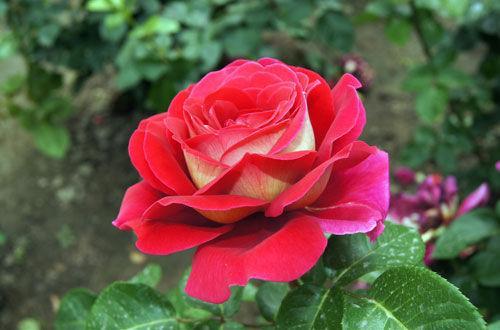The rose at home will blossom in the coming year when it is cut in September and the leaves will be bright green.

Autumn is a good time for rose softwood cuttings, when rose is in the growing season, it is important to protect mother leaves and prevent shedding when using tender wood cuttings. Because the mother leaf now undertakes the task of forming callus, producing adventitious roots and axillary bud sprouting leaves in the process of cuttings survival. Therefore, it is more important to ensure that the mother leaves do not fall off, especially for softwood cuttings in autumn. It must be noted that cuttings must not be cut from the diseased mother plant, and the seedbed and media should be strictly disinfected and sterilized, and can see the light as soon as possible, do a good job of seedbed ventilation, and ensure to improve the survival rate of rose cutting.
In September, there may be a "fake live" phenomenon when cutting, when selecting cuttings, you can not choose branches that have sprouted shoots to do cuttings. Especially when using tender wood cuttings in the growing season, we should also pay attention to selecting branches with high maturity, full axillary buds and ungerminated branches as cuttings. If there is an urgent need to use the germinated branches of axillary buds as cuttings, and when the length is more than long, the germinated section can be cut off and reused.
Secondly, if it is a short branch, the germinated axillary buds can be removed with a sharp knife or completely removed to restrain its development and let the lower axillary buds sprout. In this way, it can be promoted to take root first, and then sprout leaves. If you want the rose cuttings to root and send leaves later, in addition to mastering the appropriate temperature and humidity, you should also pay special attention to making the temperature of the cutting seedbed medium 1-2 ℃ higher than the air temperature, so that the nutrition inside the cuttings can be transferred to the lower end, first for the rooting needs of the lower part, and can promote the husband to root and then send leaves.
When the water is inserted into the rose, you should pay attention to changing the water frequently, do not completely pour the original water for a new one, and leave 1/3 or 1/2, so as to add some new water to better protect the rooting environment. If the temperature is suitable, the incision healed about 3 weeks after insertion, and it began to take root after 1 month, indicating that the cuttings had survived.
When the root is about 2 cm long, it will be taken out and planted. For too long, the root system will change from white to yellow, or even rot. As the new roots are fragile and easy to break, planting must be careful. If potted, first install the soil in the pot, it is best to use culture soil in the lower part and plain soil in the upper part, and pour it with water. After the bottom of the basin stops running, scrape the soil flat and press it slightly.
Where the rose is planted, it should be ventilated and get sunshine for more than half a day. This is the first condition that it can blossom like flowers. If it is placed in a half-cloudy and half-sunny place or in a shady place with insufficient light, it can only bloom in spring and autumn at most in a year. Therefore, for families whose living conditions can not meet the requirements of light, it is best not to plant Chinese roses but to plant more shady flowers.
Here is a gathering place for flower lovers, sharing flower pot conservation skills, welcome to follow and exchange.
- Prev

After the Mid-Autumn Festival, these three kinds of plants will have to wait half a year for cutting and missing this autumn.
After the Mid-Autumn Festival, there is no summer heat, and the potted plants at home are growing rapidly. For me, who loves succulent plants, I will certainly plant more succulent plants in this season. After all, pots take root quickly, and some plants can.
- Next

Cut off the branches of the rose and soak it in water until the blossom can't be stopped.
A few days ago, I mentioned the planting of rose in an article about Huahua. It is not only autumn, but also a cuttage for rose to make the rose grow thicker and bloom more exuberantly. A friend who has just begun to grow flowers told.
Related
- Wuhan Hospital Iron Tree Blooming Result Was Instantly Frightened by the Gardener Master
- Which variety of camellia is the most fragrant and best? Which one do you like best?
- What is the small blue coat, the breeding methods and matters needing attention of the succulent plant
- Dormancy time and maintenance management of succulent plants during dormancy
- Minas succulent how to raise, Minas succulent plant pictures
- What are the varieties of winter succulent plants
- How to raise succulent plants in twelve rolls? let's take a look at some experience of breeding twelve rolls.
- Attention should be paid to water control for succulent plants during dormant period (winter and summer)
- Watering experience of twelve rolls of succulent plants
- Techniques for fertilizing succulent plants. An article will let you know how to fertilize succulent plants.

